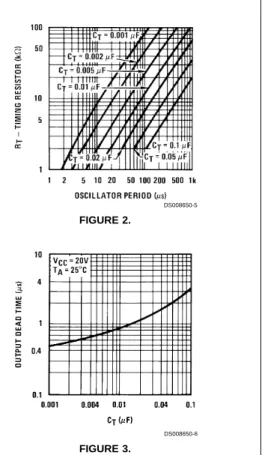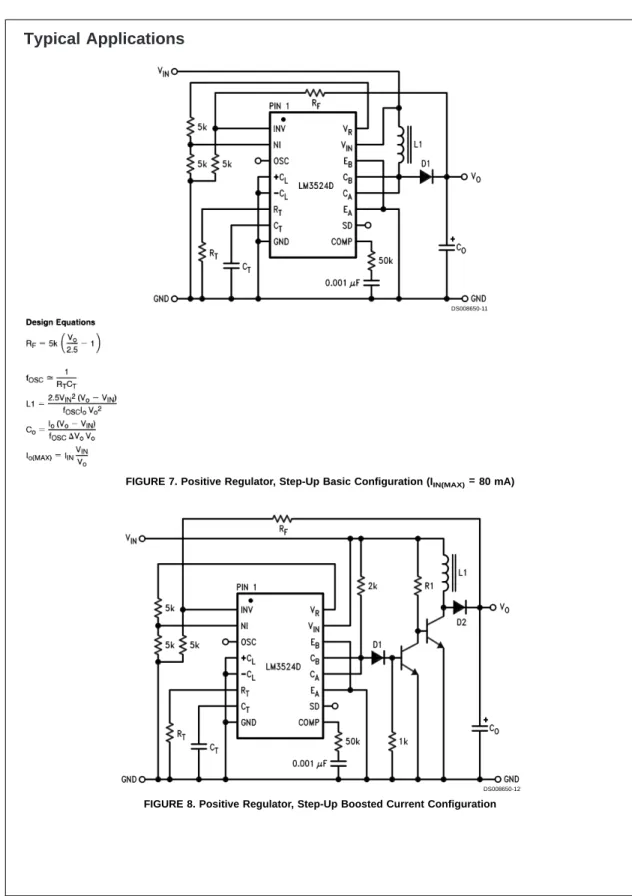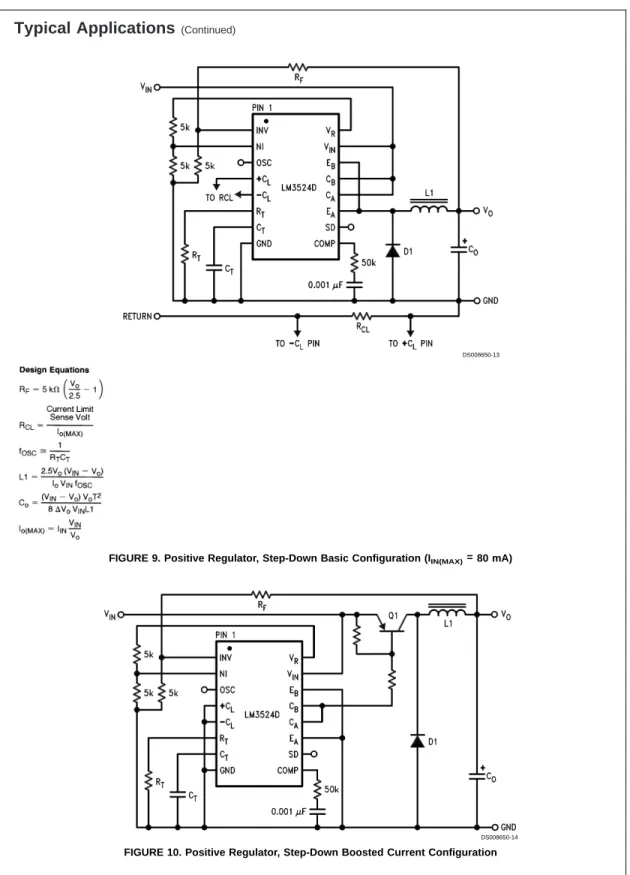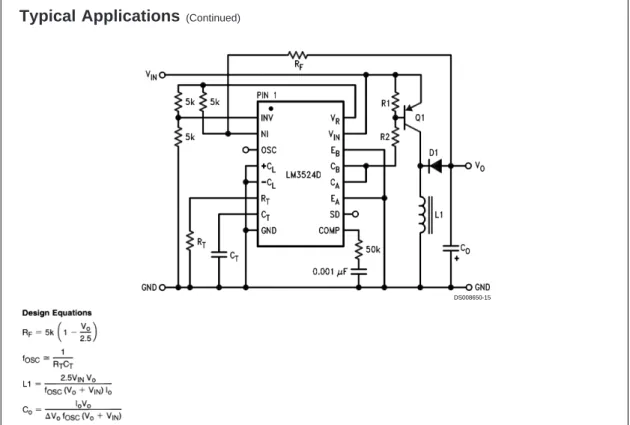LM2524D/LM3524D
Regulating Pulse Width Modulator
General Description
The LM3524D family is an improved version of the industry standard LM3524. It has improved specifications and addi-tional features yet is pin for pin compatible with existing 3524 families. New features reduce the need for additional exter-nal circuitry often required in the origiexter-nal version. The LM3524D has a±1% precision 5V reference. The cur-rent carrying capability of the output drive transistors has been raised to 200 mA while reducing VCEsatand increasing VCEbreakdown to 60V. The common mode voltage range of the error-amp has been raised to 5.5V to eliminate the need for a resistive divider from the 5V reference.
In the LM3524D the circuit bias line has been isolated from the shut-down pin. This prevents the oscillator pulse ampli-tude and frequency from being disturbed by shut-down. Also at high frequencies (≅300 kHz) the max. duty cycle per out-put has been improved to 44% compared to 35% max. duty cycle in other 3524s.
In addition, the LM3524D can now be synchronized exter-nally, through pin 3. Also a latch has been added to insure
one pulse per period even in noisy environments. The LM3524D includes double pulse suppression logic that in-sures when a shut-down condition is removed the state of the T-flip-flop will change only after the first clock pulse has arrived. This feature prevents the same output from being pulsed twice in a row, thus reducing the possibility of core saturation in push-pull designs.
Features
n Fully interchangeable with standard LM3524 family
n ±1% precision 5V reference with thermal shut-down
n Output current to 200 mA DC
n 60V output capability
n Wide common mode input range for error-amp
n One pulse per period (noise suppression)
n Improved max. duty cycle at high frequencies
n Double pulse suppression
n Synchronize through pin 3
Absolute Maximum Ratings
(Note 5) If Military/Aerospace specified devices are required, please contact the National Semiconductor Sales Office/ Distributors for availability and specifications.Supply Voltage 40V
Collector Supply Voltage
(LM2524D) 55V
(LM3524D) 40V
Output Current DC (each) 200 mA
Oscillator Charging Current (Pin 7) 5 mA
Internal Power Dissipation 1W
Operating Junction Temperature Range (Note 2)
LM2524D −40˚C to +125˚C
LM3524D 0˚C to +125˚C
Maximum Junction Temperature 150˚
Storage Temperature Range −65˚C to +150˚C Lead Temperature (Soldering 4 sec.)
M, N Pkg. 260˚C
Electrical Characteristics
(Note 1)LM2524D LM3524D
Symbol Parameter Conditions Tested Design Tested Design Units
Typ Limit Limit Typ Limit Limit
(Note 3) (Note 4) (Note 3) (Note 4)
REFERENCE SECTION
VREF Output Voltage 5 4.85 4.80 5 4.75 VMin
5.15 5.20 5.25 VMax
VRLine Line Regulation VIN= 8V to 40V 10 15 30 10 25 50 mVMax
VRLoad Load Regulation IL= 0 mA to 20 mA 10 15 25 10 25 50 mVMax
Ripple Rejection f = 120 Hz 66 66 dB
IOS Short Circuit VREF= 0 25 25 mA Min
Current 50 50
180 200 mA Max
NO Output Noise 10 Hz≤f≤10 kHz 40 100 40 100 µVrms Max
Long Term TA= 125˚C 20 20 mV/kHr
Stability
OSCILLATOR SECTION
fOSC Max. Freq. RT= 1k, CT= 0.001 µF 550 500 350 kHzMin
(Note 7)
fOSC Initial RT= 5.6k, CT= 0.01 µF 17.5 17.5 kHzMin
Accuracy (Note 7) 20 20
22.5 22.5 kHzMax
RT= 2.7k, CT= 0.01 µF 34 30 kHzMin
(Note 7) 38 38
42 46 kHzMax
∆fOSC Freq. Change VIN= 8 to 40V 0.5 1 0.5 1.0 %Max
with VIN
∆fOSC Freq. Change TA= −55˚C to +125˚C
with Temp. at 20 kHz RT= 5.6k, 5 5 %
CT= 0.01 µF
VOSC Output Amplitude RT= 5.6k, CT= 0.01 µF 3 2.4 3 2.4 VMin
(Pin 3) (Note 8)
tPW Output Pulse RT= 5.6k, CT= 0.01 µF 0.5 1.5 0.5 1.5 µsMax
Width (Pin 3)
Sawtooth Peak RT= 5.6k, CT= 0.01 µF 3.4 3.6 3.8 3.8 VMax
Voltage
Sawtooth Valley RT= 5.6k, CT= 0.01 µF 1.1 0.8 0.6 0.6 VMin
Voltage
ERROR-AMP SECTION
VIO Input Offset VCM= 2.5V 2 8 10 2 10 mVMax
Voltage
Electrical Characteristics
(Continued)(Note 1)
LM2524D LM3524D
Symbol Parameter Conditions Tested Design Tested Design Units
Typ Limit Limit Typ Limit Limit
(Note 3) (Note 4) (Note 3) (Note 4)
ERROR-AMP SECTION
Current
IIO Input Offset VCM= 2.5V 0.5 1.0 1 0.5 1 µAMax
Current
ICOSI Compensation VIN(I)− VIN(NI)= 150 mV 65 65 µAMin
Current (Sink) 95 95
125 125 µAMax
ICOSO Compensation VIN(NI)− VIN(I)= 150 mV −125 −125 µAMin
Current (Source) −95 −95
−65 −65 µAMax
AVOL Open Loop Gain RL=∞, VCM= 2.5 V 80 74 60 80 70 60 dBMin
VCMR Common Mode 1.5 1.4 1.5 VMin
Input Voltage Range 5.5 5.4 5.5 VMax
CMRR Common Mode 90 80 90 80 dBMin
Rejection Ratio
GBW Unity Gain AVOL= 0 dB, VCM= 2.5V 3 2 MHz
Bandwidth
VO Output Voltage RL=∞ 0.5 0.5 VMin
Swing 5.5 5.5 VMax
PSRR Power Supply VIN= 8 to 40V 80 70 80 65 dbMin
Rejection Ratio
COMPARATOR SECTION
Minimum Duty Pin 9 = 0.8V, 0 0 0 0 %Max
Cycle [RT= 5.6k, CT= 0.01 µF]
Maximum Duty Pin 9 = 3.9V, 49 45 49 45 %Min
Cycle [RT= 5.6k, CT= 0.01 µF]
Maximum Duty Pin 9 = 3.9V, 44 35 44 35 %Min
Cycle [RT= 1k, CT= 0.001 µF]
VCOMPZ Input Threshold Zero Duty Cycle 1 1 V
(Pin 9)
VCOMPM Input Threshold Maximum Duty Cycle 3.5 3.5 V
(Pin 9)
IIB Input Bias −1 −1 µA
Current
CURRENT LIMIT SECTION
VSEN Sense Voltage V(Pin 2)− V(Pin 1)≥ 180 180 mVMin
150 mV 200 200
220 220 mVMax
TC-Vsense Sense Voltage T.C. 0.2 0.2 mV/˚C
Common Mode −0.7 −0.7 VMin
Voltage Range V5− V4= 300 mV 1 1 VMax
SHUT DOWN SECTION
VSD High Input V(Pin 2)− V(Pin 1)≥ 1 0.5 1 0.5 VMin
Voltage 150 mV 1.5 1.5 VMax
ISD High Input I(pin 10) 1 1 mA
Current
OUTPUT SECTION (EACH OUTPUT)
VCES Collector Emitter IC≤100 µA 55 40 VMin
Electrical Characteristics
(Continued)(Note 1)
LM2524D LM3524D
Symbol Parameter Conditions Tested Design Tested Design Units
Typ Limit Limit Typ Limit Limit
(Note 3) (Note 4) (Note 3) (Note 4)
OUTPUT SECTION (EACH OUTPUT)
ICES Collector Leakage VCE= 60V
Current VCE= 55V 0.1 50 µAMax
VCE= 40V 0.1 50
VCESAT Saturation IE= 20 mA 0.2 0.5 0.2 0.7 VMax
Voltage IE= 200 mA 1.5 2.2 1.5 2.5
VEO Emitter Output IE= 50 mA 18 17 18 17 VMin
Voltage
tR Rise Time VIN= 20V,
IE= −250 µA 200 200 ns
RC= 2k
tF Fall Time RC= 2k 100 100 ns
SUPPLY CHARACTERISTICS SECTION
VIN Input Voltage After Turn-on 8 8 VMin
Range 40 40 VMax
T Thermal Shutdown (Note 2) 160 160 ˚C
Temp.
IIN Stand By Current VIN= 40V (Note 6) 5 10 5 10 mA
Note 1: Unless otherwise stated, these specifications apply for TA= TJ= 25˚C. Boldface numbers apply over the rated temperature range: LM2524D is −40˚ to 85˚C and LM3524D is 0˚C to 70˚C. VIN= 20V and fOSC= 20 kHz.
Note 2: For operation at elevated temperatures, devices in the N package must be derated based on a thermal resistance of 86˚C/W, junction to ambient. Devices in the M package must be derated at 125˚C/W, junction to ambient.
Note 3: Tested limits are guaranteed and 100% tested in production.
Note 4: Design limits are guaranteed (but not 100% production tested) over the indicated temperature and supply voltage range. These limits are not used to cal-culate outgoing quality level.
Note 5: Absolute maximum ratings indicate limits beyond which damage to the device may occur. DC and AC electrical specifications do not apply when operating the device beyond its rated operating conditions.
Note 6: Pins 1, 4, 7, 8, 11, and 14 are grounded; Pin 2 = 2V. All other inputs and outputs open.
Note 7: The value of a Ctcapacitor can vary with frequency. Careful selection of this capacitor must be made for high frequency operation. Polystyrene was used in this test. NPO ceramic or polypropylene can also be used.
Note 8: OSC amplitude is measured open circuit. Available current is limited to 1 mA so care must be exercised to limit capacitive loading of fast pulses.
Typical Performance Characteristics
Switching Transistor Peak Output Current vs Temperature
DS008650-28
Maximum Average Power Dissipation (N, M Packages)
DS008650-29
Maximum & Minimum Duty Cycle Threshold Voltage
Typical Performance Characteristics
(Continued)Test Circuit
Output Transistor Saturation Voltage
DS008650-31
Output Transistor Emitter Voltage
DS008650-32
Reference Transistor Peak Output Current
DS008650-33
Standby Current vs Voltage
DS008650-34
Standby Current vs Temperature
DS008650-35
Current Limit Sense Voltage
DS008650-36
Functional Description
INTERNAL VOLTAGE REGULATOR
The LM3524D has an on-chip 5V, 50 mA, short circuit pro-tected voltage regulator. This voltage regulator provides a supply for all internal circuitry of the device and can be used as an external reference.
For input voltages of less than 8V the 5V output should be shorted to pin 15, VIN, which disables the 5V regulator. With these pins shorted the input voltage must be limited to a maximum of 6V. If input voltages of 6V–8V are to be used, a pre-regulator, as shown inFigure 1, must be added.
OSCILLATOR
The LM3524D provides a stable on-board oscillator. Its fre-quency is set by an external resistor, RTand capacitor, CT. A graph of RT, CTvs oscillator frequency is shown isFigure 2. The oscillator’s output provides the signals for triggering an internal flip-flop, which directs the PWM information to the outputs, and a blanking pulse to turn off both outputs during transitions to ensure that cross conduction does not occur. The width of the blanking pulse, or dead time, is controlled by the value of CT, as shown inFigure 3. The recommended values of RTare 1.8 kΩto 100 kΩ, and for CT, 0.001 µF to 0.1 µF.
If two or more LM3524D’s must be synchronized together, the easiest method is to interconnect all pin 3 terminals, tie all pin 7’s (together) to a single CT, and leave all pin 6’s open except one which is connected to a single RT. This method works well unless the LM3524D’s are more than 6" apart. A second synchronization method is appropriate for any cir-cuit layout. One LM3524D, designated as master, must have its RTCT set for the correct period. The other slave LM3524D(s) should each have an RTCTset for a 10% longer period. All pin 3’s must then be interconnected to allow the master to properly reset the slave units.
The oscillator may be synchronized to an external clock source by setting the internal free-running oscillator fre-quency 10% slower than the external clock and driving pin 3 with a pulse train (approx. 3V) from the clock. Pulse width should be greater than 50 ns to insure full synchronization.
ERROR AMPLIFIER
The error amplifier is a differential input, transconductance amplifier. Its gain, nominally 86 dB, is set by either feedback or output loading. This output loading can be done with ei-ther purely resistive or a combination of resistive and reac-tive components. A graph of the amplifier’s gain vs output load resistance is shown inFigure 4.
The output of the amplifier, or input to the pulse width modu-lator, can be overridden easily as its output impedance is very high (ZO≅5 MΩ). For this reason a DC voltage can be DS008650-10
*Minimum COof 10 µF required for stability.
Functional Description
(Continued)applied to pin 9 which will override the error amplifier and force a particular duty cycle to the outputs. An example of this could be a non-regulating motor speed control where a variable voltage was applied to pin 9 to control motor speed. A graph of the output duty cycle vs the voltage on pin 9 is shown inFigure 5.
The duty cycle is calculated as the percentage ratio of each output’s ON-time to the oscillator period. Paralleling the out-puts doubles the observed duty cycle.
The amplifier’s inputs have a common-mode input range of 1.5V–5.5V. The on board regulator is useful for biasing the inputs to within this range.
CURRENT LIMITING
The function of the current limit amplifier is to override the er-ror amplifier’s output and take control of the pulse width. The output duty cycle drops to about 25% when a current limit sense voltage of 200 mV is applied between the +CLand −CLsense terminals. Increasing the sense voltage approxi-mately 5% results in a 0% output duty cycle. Care should be taken to ensure the −0.7V to +1.0V input common-mode range is not exceeded.
In most applications, the current limit sense voltage is pro-duced by a current through a sense resistor. The accuracy of this measurement is limited by the accuracy of the sense re-sistor, and by a small offset current, typically 100 µA, flowing from +CL to −CL.
OUTPUT STAGES
The outputs of the LM3524D are NPN transistors, capable of a maximum current of 200 mA. These transistors are driven 180˚ out of phase and have non-committed open collectors and emitters as shown inFigure 6.
DS008650-8
FIGURE 5.
DS008650-9
Typical Applications
DS008650-11
FIGURE 7. Positive Regulator, Step-Up Basic Configuration (IIN(MAX)= 80 mA)
DS008650-12
Typical Applications
(Continued)DS008650-13
FIGURE 9. Positive Regulator, Step-Down Basic Configuration (IIN(MAX)= 80 mA)
DS008650-14
Typical Applications
(Continued)BASIC SWITCHING REGULATOR THEORY AND APPLICATIONS
The basic circuit of a step-down switching regulator circuit is shown inFigure 12, along with a practical circuit design us-ing the LM3524D inFigure 15.
The circuit works as follows: Q1 is used as a switch, which has ON and OFF times controlled by the pulse width modu-lator. When Q1 is ON, power is drawn from VINand supplied to the load through L1; VAis at approximately VIN, D1 is re-verse biased, and Cois charging. When Q1 turns OFF the in-ductor L1 will force VAnegative to keep the current flowing in it, D1 will start conducting and the load current will flow through D1 and L1. The voltage at VAis smoothed by the L1, Co filter giving a clean DC output. The current flowing through L1 is equal to the nominal DC load current plus some∆ILwhich is due to the changing voltage across it.A good rule of thumb is to set∆ILP-P≅40% x Io.
DS008650-15
FIGURE 11. Boosted Current Polarity Inverter
DS008650-16
Typical Applications
(Continued)Neglecting VSAT, VD, and settling∆IL +=∆
IL −
;
where T = Total Period
The above shows the relation between VIN, Voand duty
cycle.
as Q1 only conducts during tON.
The efficiency,η, of the circuit is:
ηMAX will be further decreased due to switching losses in Q1. For this reason Q1 should be selected to have the maxi-mum possible fT, which implies very fast rise and fall times.
CALCULATING INDUCTOR L1
Since∆IL+ =∆IL −= 0.4I
o
Solving the above for L1
where: L1 is in Henrys f is switching frequency in Hz
Also, see LM1578 data sheet for graphical methods of induc-tor selection.
CALCULATING OUTPUT FILTER CAPACITOR Co:
Figure 13 shows L1’s current with respect to Q1’s tONand
tOFFtimes (VAis at the collector of Q1). This curent must
flow to the load and Co. Co’s current will then be the
differ-ence between IL, and Io.
Ico= IL− Io
FromFigure 13 it can be seen that current will be flowing into Cofor the second half of tONthrough the first half of tOFF, or
a time, tON/2 + tOFF/2. The current flowing for this time is ∆IL/4. The resulting∆Vcor∆Vois described by:
For best regulation, the inductor’s current cannot be allowed to fall to zero. Some minimum load current Io, and thus
in-ductor current, is required as shown below:
DS008650-17
Typical Applications
(Continued)A complete step-down switching regulator schematic, using the LM3524D, is illustrated inFigure 15. Transistors Q1 and Q2 have been added to boost the output to 1A. The 5V regu-lator of the LM3524D has been divided in half to bias the er-ror amplifier’s non-inverting input to within its common-mode
range. Since each output transistor is on for half the period, actually 45%, they have been paralleled to allow longer pos-sible duty cycle, up to 90%. This makes a lower pospos-sible in-put voltage. The outin-put voltage is set by:
where VNIis the voltage at the error amplifier’s non-inverting
input.
Resistor R3 sets the current limit to:
Figures 16, 17 and show a PC board layout and stuffing dia-gram for the 5V, 1A regulator ofFigure 15. The regulator’s performance is listed inTable 1.
DS008650-19
FIGURE 14. Inductor Current Slope in Step-Down Regulator
DS008650-20
*Mounted to Staver Heatsink No. V5-1. Q1 = BD344
Q2 = 2N5023
L1 =>40 turns No. 22 wire on Ferroxcube No. K300502 Torroid core.
Typical Applications
(Continued)TABLE 1.
Parameter Conditions Typical
Characteristics
Output Voltage VIN= 10V, Io= 1A 5V
Switching Frequency VIN= 10V, Io= 1A 20 kHz
Short Circuit VIN= 10V 1.3A
Current Limit
Load Regulation VIN= 10V 3 mV
Io= 0.2 − 1A
Line Regulation ∆VIN= 10 − 20V, 6 mV
Io= 1A
Efficiency VIN= 10V, Io= 1A 80%
Output Ripple VIN= 10V, Io= 1A 10 mVp-p
DS008650-21
FIGURE 16. 5V, 1 Amp Switching Regulator, Foil Side
DS008650-22
Typical Applications
(Continued)THE STEP-UP SWITCHING REGULATOR
Figure 18 shows the basic circuit for a step-up switching regulator. In this circuit Q1 is used as a switch to alternately apply VINacross inductor L1. During the time, tON, Q1 is ON and energy is drawn from VINand stored in L1; D1 is reverse biased and Iois supplied from the charge stored in Co. When Q1 opens, tOFF, voltage V1 will rise positively to the point where D1 turns ON. The output current is now supplied through L1, D1 to the load and any charge lost from Co dur-ing tONis replenished. Here also, as in the step-down regu-lator, the current through L1 has a DC component plus some
∆IL.∆ILis again selected to be approximately 40% of IL. Fig-ure 19 shows the inductor’s current in relation to Q1’s ON and OFF times.
Since∆IL+ =∆IL−, VINtON= VotOFF− VINtOFF,
and neglecting VSATand VD1
The above equation shows the relationship between VIN, Vo
and duty cycle.
In calculating input current IIN(DC), which equals the
induc-tor’s DC current, assume first 100% efficiency:
forη= 100%, POUT= PIN
This equation shows that the input, or inductor, current is larger than the output current by the factor (1 + tON/tOFF).
Since this factor is the same as the relation between Voand
VIN, IIN(DC)can also be expressed as:
So far it is assumedη= 100%, where the actual efficiency or
ηMAXwill be somewhat less due to the saturation voltage of
Q1 and forward on voltage of D1. The internal power loss due to these voltages is the average ILcurrent flowing, or IIN,
through either VSATor VD1. For VSAT= VD1= 1V this power
loss becomes IIN(DC)(1V).ηMAXis then:
This equation assumes only DC losses, howeverηMAXis
fur-ther decreased because of the switching time of Q1 and D1.
DS008650-23
FIGURE 18. Basic Step-Up Switching Regulator
DS008650-24
Typical Applications
(Continued)In calculating the output capacitor Coit can be seen that Co supplies Ioduring tON. The voltage change on Coduring this time will be some∆Vc=∆Voor the output ripple of the regu-lator. Calculation of Cois:
where: Cois in farads, f is the switching frequency, ∆Vois the p-p output ripple
Calculation of inductor L1 is as follows:
VINis applied across L1
where: L1 is in henrys, f is the switching frequency in Hz To apply the above theory, a complete step-up switching regulator is shown inFigure 20. Since VINis 5V, VREFis tied
to VIN. The input voltage is divided by 2 to bias the error
am-plifier’s inverting input. The output voltage is:
The network D1, C1 forms a slow start circuit.
This holds the output of the error amplifier initially low thus reducing the duty-cycle to a minimum. Without the slow start circuit the inductor may saturate at turn-on because it has to supply high peak currents to charge the output capacitor from 0V. It should also be noted that this circuit has no sup-ply rejection. By adding a reference voltage at the non-inverting input to the error amplifier, seeFigure 21, the input voltage variations are rejected.
Typical Applications
(Continued)DS008650-25
L1 =>25 turns No. 24 wire on Ferroxcube No. K300502 Toroid core.
FIGURE 20. 15V, 0.5A Step-Up Switching Regulator
DS008650-26
FIGURE 21. Replacing R3/R4 Divider inFigure 20 with
Reference Circuit Improves Line Regulation
DS008650-27
Connection Diagram
DS008650-2
Top View
Order Number LM2524DN or LM3524DN See NS Package Number N16E
Physical Dimensions
inches (millimeters) unless otherwise notedPhysical Dimensions
inches (millimeters) unless otherwise noted (Continued)LIFE SUPPORT POLICY
NATIONAL’S PRODUCTS ARE NOT AUTHORIZED FOR USE AS CRITICAL COMPONENTS IN LIFE SUPPORT DEVICES OR SYSTEMS WITHOUT THE EXPRESS WRITTEN APPROVAL OF THE PRESIDENT AND GENERAL COUNSEL OF NATIONAL SEMICONDUCTOR CORPORATION. As used herein:
1. Life support devices or systems are devices or systems which, (a) are intended for surgical implant into the body, or (b) support or sustain life, and whose failure to perform when properly used in accordance with instructions for use provided in the labeling, can be reasonably expected to result in a significant injury to the user.
2. A critical component is any component of a life support device or system whose failure to perform can be reasonably expected to cause the failure of the life support device or system, or to affect its safety or effectiveness.
National Semiconductor Corporation Americas Tel: 1-800-272-9959 Fax: 1-800-737-7018 Email: support@nsc.com National Semiconductor Europe
Fax: +49 (0) 1 80-530 85 86 Email: europe.support@nsc.com Deutsch Tel: +49 (0) 1 80-530 85 85 English Tel: +49 (0) 1 80-532 78 32 Français Tel: +49 (0) 1 80-532 93 58 Italiano Tel: +49 (0) 1 80-534 16 80
National Semiconductor Asia Pacific Customer Response Group Tel: 65-2544466 Fax: 65-2504466 Email: sea.support@nsc.com National Semiconductor Japan Ltd. Tel: 81-3-5639-7560 Fax: 81-3-5639-7507 www.national.com
Molded Dual-In-Line Package (N) Order Number LM2524DN or LM3524DN
NS Package Number N16E







